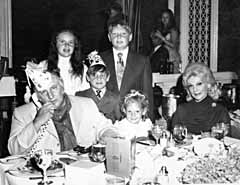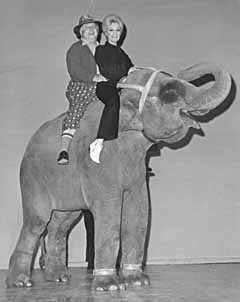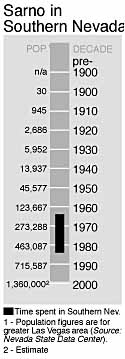Jay Sarno



You can get an argument over who started the Las Vegas Strip, but there’s no question it was Jay Sarno who changed it forever. The fast-living genius behind Caesars Palace and Circus Circus invented the fantasy resort and the modern family resort, twin ideas that have guided the past three decades of Las Vegas’ growth.
He lived so large that it is difficult to exaggerate his appetites for gambling, women or food. Or, for that matter, his creativity and generosity.
Unlike most casino moguls, Sarno was himself a gambler.
“I would say in one evening, at craps, he could swing a quarter of a million one way or the other,” said his former wife, Joyce Sarno Keys, who divorced him in 1974. “I remember once he had won almost $100,000, lost it all back and left owing $100,000.”
Sarno probably liked playing with money because he grew up without much. Born in 1922, he spent his adolescence in the Depression. His cabinetmaker father and homemaker mother, who lived in Missouri, pinched pennies to make sure all seven of their children attended college.
A business major at the University of Missouri, Sarno set up on-campus businesses delivering laundry and selling corsages. His classmate Stanley Mallin, who would become his lifelong business partner, said Sarno was already a plunger even in those days.
“He would pawn his clothes for gambling money,” remembered Mallin, 76, in a 1999 interview. “One of his older brothers, who was a doctor, would bail him out every few months; let him get his clothes back.”
Both partners served in World War II in the South Pacific. They returned to finish college, then teamed up as tile contractors in booming Miami. “If the season was good you got paid and if it wasn’t, you didn’t,” said Mallin. They tried their luck in Atlanta, building government-subsidized housing. The downside of working with Sarno was his impracticality, remembered Mallin. “Once we needed a truck to haul tile, and he took the money we had for that and bought a convertible.”
But the upside was that Sarno had good ideas. “Jay had kind of grown up in the hotel business, working summers for his brother,” said Mallin. The partners saw opportunity in motor hotels, merging drive-up convenience with luxury accommodations and service formerly associated with traditional hotels. But banks wouldn’t loan them money.
Then, said Mallin, the partners got the break of their lives. They met Teamsters boss Jimmy Hoffa and the union’s money manager, Allen Dorfman. The first loan Dorfman ever arranged from the Central States Pension Fund was to build the Atlanta Cabana motor hotel in 1958.
“Jimmy and Jay just hit if off,” said Mallin. “They were different in some ways; Jay lived high while Jimmy lived in the same house he bought for $7,000. But they were both hard-driving guys, impulsive, almost compulsive.”
Jo Harris, who had just finished architecture school at Georgia Tech and was working as an interior designer, asked for a job decorating the Atlanta Cabana. “Jay said, `I like your work but if anybody is going to work for me I expect her to be my girl,’ ” Harris remembered.
“I said, `I’ve been to Miami and I know that if I wanted to be a prostitute I could earn six times what you’re offering me.’ I wanted to be hired for my ability, plus I was married.
“So that was the end of that, but two weeks later he called and said I wouldn’t have to be his girl. He offered me $100 a day, which was all the money in the world.” Harris would design for Sarno as long as he lived.
They filled the Atlanta Cabana with fountains and statues and mirrors. The operation was immediately successful, so Sarno and Mallin built others.
They built Cabanas in Palo Alto, Calif., and in Dallas, and there were two others on the drawing boards when a side trip to Las Vegas to make an offering to the god of craps changed their direction. Joyce said, “He could see the kind of money that was being exchanged, mostly going in favor of the hotels, and decided that just one big hotel with a casino would make more money than a Hilton without it.”
“He was a man who loathed plain vanilla,” said Sarno’s daughter September. “Las Vegas hotels at that time just oozed mediocrity.” They attempted to distinguish themselves by adopting names that sounded vaguely French, or vaguely Moroccan, or Western American, but the theme was skin-deep.
Nobody would ever say that about the one Sarno and Mallin and Harris began building in 1964.
Caesars Palace was a fantasy world where every guest was a Caesar or a Cleopatra. This theme made it easy to escape the boring mores of mainstream America, to loosen up and bet a hundred on a hardway eight.
“Jay insisted that people be in uniform from head to toe,” said Harris. “We sketched our ideas but brought in a wardrobe mistress, as if we were costuming a show, to execute them.” Waitresses wore sexy, short, bare shouldered togas; desk clerks wore tunics suggesting Roman military fashions. The very notepaper in the rooms looked like parchment.
But there were more subtle innovations. All the amenities — like showrooms, shops, restaurants, and pool entrance — radiated off the casino. “It meant that to go anywhere you had to go past the casino, and it gave a sense of being around the action all the time,” said Harris.
“We hit lightning in a bottle with Caesars,” recalled Mallin happily. “It took right off. It was the nicest thing in Las Vegas and maybe in the country.”
From the time Caesars opened in 1966, the most successful new gambling resorts would be those that, like Caesars, carried out some escapist theme.
Caesars cost $24 million and sold in 1969 for $60 million.
Meanwhile, Sarno and Mallin were trying the next new idea — a resort embodying everybody’s childhood fantasy of running away to join the circus. Circus Circus was built in the shape of a tent, and trapeze artists performed overhead. A live pink elephant “flew” around the casino on a sort of overhead tram. Sarno himself would dress up as a ringmaster and walk through the casino.
By adding a midway to the casino, Sarno had begun catering not only to families with children, but to children themselves.
None of it worked well enough to turn a profit. Mallin says the mistake was opening without hotel rooms to provide a captive audience. The theory was that the place would be interesting enough to draw visitors from other casinos. It did, but most came to gawk and not gamble.
“About that time there was a gasoline crunch, and you could shoot a cannon down the Strip and not hit anybody,” Mallin said. “We didn’t weather that. We lost $5 (million) or $6 million, so we leased it to Bill Bennett and Bill Pennington.” Bennett had casino-hotel experience as an executive with Del Webb Corp., and Pennington was his partner in a slot machine business.
“They struggled the first year, then conditions turned around, and to tell the truth, they were probably better operators than we were,” said Mallin. “They exercised their option to buy after a few years, and Circus just went terrific.”
Circus Circus became by some measures the most successful of all gaming companies, involved in Excalibur, the Luxor, the recently-opened luxury resort Mandalay Bay, as well as casinos in Reno, Laughlin, and out-of-state locations.
Sarno was sometimes called a “front” for mob interests associated with the Teamsters. In a 1979 trial involving skimming at other casinos, gaming executive Carl Thomas testified that he had skimmed Circus Circus profits. Mallin, however, denies the Teamsters played any role except lender.
Tony Spilotro, a Mafia street-rackets boss, infamously owned a gift shop concession at Circus Circus. “I think he was introduced by a Teamsters guy,” said Mallin, “but he introduced himself by the name Stewart. When we did learn who he was and told him he had to leave, that it was making problems for us, he didn’t raise any objections.”
Mallin became a full-time investor. Sarno tried the rest of his life to raise money for a giant hotel to be called the Grandissimo. He envisioned 6,000 rooms. One of its key features was to be lots of waterfalls and fountains. If that sounds a good deal like Steve Wynn’s highly successful Mirage Resort, it’s no accident. “Steve often mentions my father in lectures,” said September. “He says he learned a lot, such as how to use water and statues, from my dad.”
The Sarnos had four children. Jay Jr., runs his own engineering firm. September is a stockbroker and senior vice president at Prudential Securities in Beverly Hills, Calif. Freddie is a stockbroker. Only Heidi Sarno Strauss remained in Las Vegas; she divides her time between her own business — a flower shop — and a family.
In the 1970s, Jay Jr. remembered, his parents took him along to a charity auction because the items being auctioned included a number of authentic mementos from America’s space program, with which he was fascinated.
“One item was a patch from the uniform of Jack Swigert, the commander of Apollo 13, and my dad started bidding on it. The bidding reached $10,000 and the other bidder dropped out and he got it. I thought he was just trying to show off. I asked `Why did you buy that?’ And he said `To give to you.’ ”
With that, Sarno handed it over as nonchalantly as another man would present a lollipop.
“That’s the first time it ever hit me: ‘My old man is crazy! I’m 12 years old and he spent $10,000 on this thing. My old man is crazy,'” Jay Jr. related. Now, however, he thinks it wasn’t a bad decision. He has kept the historic patch clean and safe nearly 30 years.
When September was 20, she took it into her head to enter the Miss Nevada contest, working hard and successfully to trim her waistline to winning proportions. “But I’m not quite 5-foot-3 and he remarked to me that tall girls always win, and he was afraid I would be very hurt.
“So he offered to arrange that I would win it. He said he thought it wouldn’t cost more than $25,000. I think he was serious.
“But I told him I wanted to do it myself, win or lose. And I made it into the Top 10 and won Miss Congeniality, so I’m really glad I didn’t let him rig it.”
After Sarno cashed out of Circus Circus he was simulta- neously flush and frustrated at his inability to get enough financing to build the Grandissimo. His boredom led him deeper into gambling, usually at the craps tables at Caesars, where he had once ruled the empire and was still treated as royalty. Not one but two of his own brothers, the hotelman Sam and the doctor Herman, had dropped dead at these tables in the excitement of a craps game.
Jay had his own fatal heart attack in a suite at the same hotel, in 1984.
But one can still see Sarnos at Caesars. September, when she comes home for a weekend in the town where she grew up, is never an overnight guest with relatives or friends, but stays, by choice, at Caesars. “I walk through the same casino I did as a kid, and I see some of the same people.” Now and then she assaults the crap tables. “It’s where I grew up,” she said. “I feel happy here. I feel close to my dad.”
Part III: A City In Full











